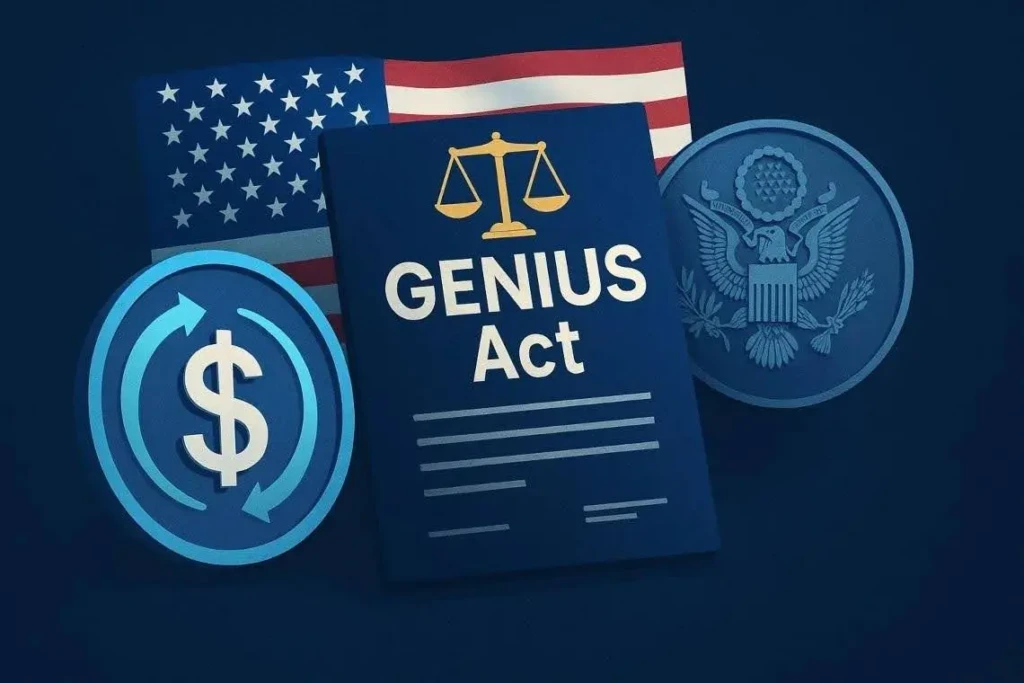GENIUS Act Overview: A Turning Point for Stablecoins
In June 2025, the U.S. Senate passed the Guiding and Establishing National Innovation for U.S. Stablecoins (GENIUS) Act, marking the first standalone federal legislation focused on dollar-pegged cryptocurrencies. With the bill now heading to the House—and President Donald Trump urging lawmakers to “take the win”—fast adoption looks likely.
The GENIUS Act overview highlights a transformative step in regulating stablecoins, offering both compliance clarity and economic opportunity. But what exactly does this bill mean for issuers, investors, and the broader U.S. financial system?
What Are Stablecoins?
Stablecoins are blockchain-based digital tokens designed to maintain a fixed value, typically pegged to the U.S. dollar. They are backed by highly liquid assets like cash and short-term U.S. Treasury bills, ensuring that each token can be redeemed for $1 at any time.
Today, stablecoin giants such as Tether’s USDT and Circle’s USDC facilitate trillions in transactions annually. They fuel crypto trading, cross-border payments, and are increasingly being tested by major retailers—including Amazon and Walmart—for real-world point-of-sale adoption.
Key Features of the GENIUS Act
The GENIUS Act overview reveals several groundbreaking provisions:
Federal Licensing of Issuers
Only Permitted Payment Stablecoin Issuers (PPSIs) may issue or sell U.S.-pegged stablecoins. Eligible applicants include banks, credit unions, and OCC-chartered non-banks.
State-Level Oversight for Small Players
Issuers with less than $10 billion in circulation can opt for state oversight, provided their framework meets federal standards.
Reserve and Transparency Requirements
All PPSIs must:
- Fully back stablecoins with high-quality liquid assets.
- Segregate reserves to prevent rehypothecation.
- Publish monthly attestations for public transparency.
Regulatory Carve-Outs
Stablecoins are explicitly excluded from being classified as securities, deposits, or bank liabilities. Instead, they fall under the Bank Secrecy Act, ensuring compliance with anti-money laundering (AML) rules.
Foreign Issuers
Non-U.S. stablecoin issuers can only operate if their home regulations are deemed “comparable” and they submit to OCC examinations.
See full legislative text here.
Winners and Losers in the Stablecoin Market
Winners
- Coinbase & USDC Ecosystem – Analysts predict a compliance advantage, boosting adoption.
- U.S. Treasury – Mandatory T-bill reserves could make stablecoin issuers a major buyer of government debt, reinforcing dollar dominance globally.
- Banks – Institutions once hesitant about crypto may now issue branded stablecoins under clear regulatory protection.
Losers
- Algorithmic Stablecoins – Tokens without strict reserves will fail compliance tests.
- Offshore Issuers – Those unwilling to accept U.S. oversight risk losing market access.
- Legacy Networks – Visa and Mastercard could see settlement volumes shift to blockchain rails.
What It Means for Everyday Users
For consumers, the GENIUS Act overview signals the arrival of faster, cheaper, and always-on digital dollars. Unlike Venmo or PayPal—which rely on legacy banking rails—GENIUS-compliant stablecoins settle transactions directly on public blockchains.
- Remittances: Sending $200 abroad currently costs ~6% in fees and takes days. With compliant stablecoins, it could cost pennies and clear in seconds.
- Retail Payments: Shopify has already enabled USDC checkout, lowering costs for merchants while offering cashback incentives for wallet payments.
Frequently Asked Questions (FAQ)
What is the GENIUS Act overview in simple terms?
The GENIUS Act overview explains that the bill creates a federal licensing framework for stablecoin issuers, ensuring reserves, audits, and consumer protections while promoting adoption.
How does the GENIUS Act affect stablecoin issuers?
Issuers must obtain a federal or state license, maintain fully backed reserves, and comply with anti-money laundering laws.
Why is the GENIUS Act important for stablecoin users?
It provides legal clarity, ensuring safer, faster, and cheaper digital dollar transactions for both consumers and businesses.
Does the GENIUS Act impact foreign stablecoin issuers?
Yes. Foreign issuers can only operate in the U.S. if their regulations are deemed comparable and they submit to U.S. oversight.
Conclusion: A New Era for Digital Dollars
The GENIUS Act overview underscores a watershed moment for U.S. crypto regulation. By creating a unified framework for stablecoins, the Act could accelerate their role in payments, remittances, and global finance—while reinforcing U.S. dollar dominance.
For investors, issuers, and policymakers, the coming years will test whether clear rules spark innovation or stifle it. What’s certain is that stablecoins are no longer operating in a legal gray zone—Washington has drawn the lines, and the world is watching.

